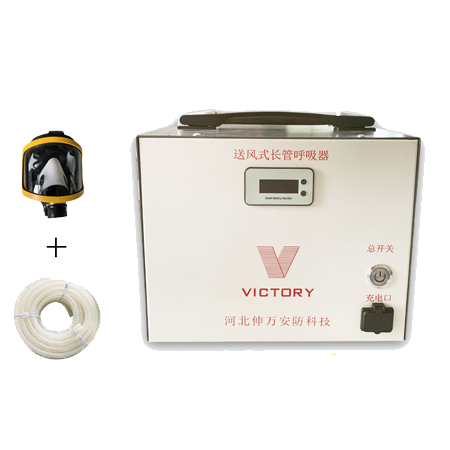A long-tube respirator is a self-priming long-tube respiratory protection device that delivers fresh air from a clean air source to the user’s breathing mask through a long tube, providing the user with safe breathing air in dangerous environments such as toxic, harmful, and hypoxic environments. The following is a detailed introduction from the aspects of working principle, main components, types, application scenarios, advantages and disadvantages:
Working Principle
The long tube respirator uses a long tube to transport clean external air to the user’s breathing mask. Air enters the long tube from the air source (such as clean outdoor air, air compressor or compressed air bottle, etc.), and then passes through the mask for the user to breathe. The exhaust gas exhaled by the user is discharged through the exhaust valve on the mask, isolated from the outside air, thereby avoiding the inhalation of harmful gases or dust.
Main components
Mask: fits tightly with the user’s face to prevent harmful gases from entering. Common ones include full-face masks and half-face masks. Full-face masks can cover the user’s mouth, nose and eyes, providing more comprehensive protection; half-face masks only cover the mouth and nose.
Long tube: used to transport air, generally made of flexible materials such as rubber, plastic, etc., the length can be customized according to actual needs, common specifications include 10 meters, 20 meters, 30 meters, etc.
Air source: the source of clean air, which can be naturally ventilated outdoor air, compressed air generated by air compressors, or pre-filled compressed air bottles, etc.
Belt or backpack: used to fix long tubes and air source equipment (such as air compressors or air bottles), reduce the burden on users, and facilitate their free movement in the work area.
Type
Self-priming long-tube respirator: relies on the user’s own breathing power to inhale air from the air source into the mask. This type of respirator has a relatively simple structure and low cost, but it has certain requirements on the user’s physical strength, and the length of the long tube cannot be too long, otherwise it will increase the breathing resistance and affect the use effect.
Electric air supply long-tube respirator: The air is transported from the air source to the mask through an electric fan. It can overcome the disadvantage of large breathing resistance of self-priming long-tube respirators, and is suitable for situations where the long tube is long or the user is weak. The electric air supply long-tube respirator can also be equipped with a filtering device to further purify the air.
High-pressure air supply long-tube respirator: uses a compressed air bottle as the air source, and the high-pressure air is decompressed and transported to the mask through a pressure reducing valve. This type of respirator is not limited by the location of the air source and is suitable for various complex environments, but the capacity of the compressed air bottle is limited, the use time is relatively short, and it needs to be replaced or inflated regularly.
Application scenarios
Chemical industry: In the chemical production process, various toxic and harmful chemicals are involved, such as acids, alkalis, organic solvents, etc. Long-tube respirators can provide safe respiratory protection for workers to prevent them from inhaling harmful gases.
Petroleum and natural gas industry: In the process of oil and natural gas extraction, refining and storage, there are flammable, explosive, toxic and harmful gases, such as hydrogen sulfide and methane. Long-tube respirators are essential personal protective equipment for workers when working in dangerous areas.
Fire rescue: At the scene of a fire, a large amount of smoke and toxic gases will be generated. When firefighters enter the fire scene for rescue and fire fighting, they need to wear long-tube respirators to protect their respiratory system.
Underground engineering: In underground working environments such as tunnel construction and mine mining, the air is usually not circulated, and there may be problems such as lack of oxygen and toxic and harmful gases. Long-tube respirators can provide necessary respiratory support for workers.
Advantages and Disadvantages
Advantages
Continuous air supply: As long as the air source is stable, the long-tube respirator can continuously provide clean air to the user, and the use time is not limited (for self-priming and electric air supply, it is affected by the air source environment or the power of the equipment; the high-pressure air supply is affected by the capacity of the gas cylinder, but the use time can be extended by replacing the gas cylinder).
Good protection effect: It can effectively isolate harmful gases, dust and smoke from the outside world, and provide users with reliable respiratory protection.
Wide range of application: The appropriate air source and long tube length can be selected according to different working environments and needs, and it is suitable for various complex environments.
Disadvantages
Limited movement: The presence of the long tube will limit the user’s range of activities, and may affect the flexibility of operation in a narrow or complex working environment.
High maintenance cost: The long-tube respirator needs to be inspected, maintained and cleaned regularly to ensure its performance and safety. At the same time, the air source equipment (such as air compressors, air bottles, etc.) also needs to be regularly maintained and replaced.
Dependence on the air source: If there is a problem with the air source, such as air compressor failure, depletion of compressed air bottles, etc., it will directly affect the use effect of the long-tube respirator.


